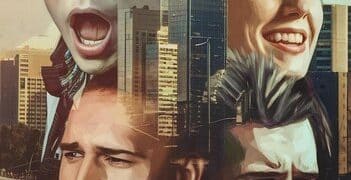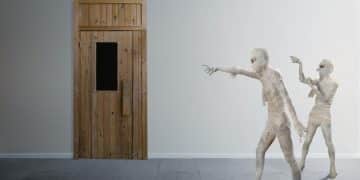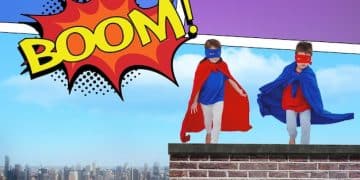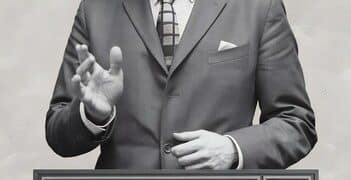The Evolution of the Anti-Hero: From Villain to Protagonist
The evolution of the anti-hero traces a fascinating arc from morally ambiguous villains to complex protagonists, reflecting society’s shifting values and its increasing willingness to embrace flawed characters.
The concept of a hero has undergone a significant transformation over the decades. While traditional heroes embody unwavering morality and selflessness, the rise of the evolution of the anti-hero: from villain to protagonist offers a refreshing, albeit complex, alternative that resonates deeply with modern audiences.
The Anti-Hero’s Origin: A Response to Traditional Archetypes
The anti-hero emerged as a direct counterpoint to the traditional hero archetype, which often felt one-dimensional and unrelatable. These conventional heroes, with their unwavering virtue and predictable actions, began to lose their appeal as audiences craved characters that mirrored the complexities and contradictions of real life.
Challenging Moral Absolutes in Storytelling
Traditional heroes often operated within a clear-cut framework of good versus evil, making their choices and motivations easily predictable. The anti-hero, on the other hand, blurs these lines, forcing audiences to confront uncomfortable truths and question conventional moral boundaries. This challenge to moral absolutes opened up new possibilities for storytelling, allowing for more nuanced and thought-provoking narratives.
Early Examples: The Seeds of Disruption
Early examples of anti-heroes can be found in literary works and classic films, such as Hamlet, or Shane. These characters, while not entirely devoid of heroic qualities, possessed significant flaws and questionable motivations that set them apart from their virtuous counterparts. Their presence marked a shift towards more complex and morally ambiguous protagonists.

- Moral Ambiguity: Early anti-heroes introduced the concept of characters who operate in the gray areas of morality, challenging simple notions of right and wrong.
- Internal Conflict: These characters often grappled with internal demons and conflicting desires, making them more relatable and human.
- Questionable Methods: Anti-heroes frequently resort to methods that traditional heroes would never consider, adding a layer of unpredictability and tension to the narrative.
The introduction of the anti-hero was not just a stylistic choice; it reflected a growing societal disillusionment with absolute authority and a desire for more authentic and relatable characters. These early examples laid the groundwork for the anti-hero’s eventual rise to prominence in mainstream media.
The Rise of the Modern Anti-Hero: Embracing Complexity
As society became more complex and nuanced, so too did its heroes. The modern anti-hero emerged as a reflection of this complexity, often possessing a dark past, questionable motivations, and a willingness to cross moral boundaries in pursuit of a greater good or personal redemption.
Breaking the Mold: Characteristics of the Modern Anti-Hero
Unlike their predecessors, modern anti-heroes are not simply flawed heroes. They often exhibit traits traditionally associated with villains, such as selfishness, ruthlessness, and a disregard for the law. However, they also possess qualities that endear them to audiences, such as loyalty, courage, and a strong sense of justice, albeit one that is often distorted or skewed.
Pop Culture Icons: Anti-Heroes in Film and Television
The rise of cable television and streaming services has provided a fertile ground for the development and exploration of anti-heroes. Shows like “Breaking Bad,” “The Sopranos,” and “Mad Men” have all featured complex and morally ambiguous protagonists who captivated audiences with their flaws, vulnerabilities, and unexpected acts of heroism. Similarly, films like “Joker” and “Deadpool” have pushed the boundaries of the anti-hero archetype, exploring the darker aspects of human nature and the blurred lines between good and evil.
- Moral Code: Modern anti-heroes often adhere to their own unique moral code, which may conflict with societal norms and expectations.
- Tragic Flaws: These characters frequently possess tragic flaws that drive their actions and lead to their ultimate downfall or redemption.
- Relatable Imperfections: Despite their flaws, modern anti-heroes often resonate with audiences because they embody the imperfections and struggles that are inherent in the human condition.
The modern anti-hero represents a departure from traditional heroic ideals, reflecting a societal shift towards accepting and even celebrating characters that are flawed, complex, and morally ambiguous. They challenge viewers to confront their own values and question the nature of good and evil.
Why Are Anti-Heroes So Appealing?
The popularity of anti-heroes stems from a variety of factors, including their relatability, their ability to challenge societal norms, and their capacity for growth and redemption. These characters offer a refreshing alternative to the often simplistic and predictable nature of traditional heroes.
Relatability: Imperfection as a Virtue
One of the key reasons why anti-heroes resonate with audiences is their relatability. Unlike traditional heroes who seem almost superhuman in their virtue, anti-heroes are flawed, vulnerable, and often struggling to overcome their own personal demons. This imperfection makes them feel more human and accessible, allowing viewers to connect with them on a deeper level.
Challenging Societal Norms: Questioning Authority
Anti-heroes often challenge societal norms and question authority, which can be particularly appealing to audiences who feel disenfranchised or disillusioned with the status quo. By breaking the rules and pushing boundaries, anti-heroes offer a sense of rebellion and empowerment, allowing viewers to vicariously experience their own desires for freedom and autonomy.
The appeal of anti-heroes lies in their ability to reflect the complexities and contradictions of human nature. They are not simply good or evil, but rather a mixture of both, making them more compelling and thought-provoking characters than their traditional counterparts. Their rise in popularity reflects a societal shift towards embracing imperfection and questioning established norms.
The Anti-Heroine: A Female Perspective
While the anti-hero has traditionally been a male-dominated archetype, the emergence of the anti-heroine has brought a fresh perspective to this complex character type. Female anti-heroes often challenge gender stereotypes and offer a more nuanced exploration of female agency and empowerment.
Breaking Gender Stereotypes: Redefining Female Strength
Anti-heroines defy traditional gender stereotypes by embracing traits traditionally associated with masculinity, such as aggression, ambition, and independence. They are not passive victims or damsels in distress, but rather active agents who take control of their own lives and destinies. This subversion of traditional gender roles can be empowering for female viewers who are looking for strong and complex female role models.
Examples: From Villanelle to Lisbeth Salander
Examples of compelling anti-heroines include Villanelle from “Killing Eve,” who is a skilled assassin with a penchant for violence, and Lisbeth Salander from “The Girl with the Dragon Tattoo,” who is a fiercely independent hacker with a troubled past. These characters are not afraid to embrace their darker sides and use their unique skills to navigate a world that is often hostile and unforgiving.
- Challenging Expectations: Anti-heroines challenge societal expectations of female behavior, offering a more diverse and complex representation of women on screen.
- Exploring Female Agency: These characters often explore themes of female agency and empowerment, allowing viewers to see women in positions of power and control.
- Reflecting Gender Inequality: Anti-heroines can also reflect the challenges and inequalities that women face in the real world, using their stories to shed light on important social issues.
The rise of the anti-heroine represents a significant step forward in the representation of women in media. These characters offer a more nuanced and complex portrayal of female agency, strength, and resilience, challenging traditional gender stereotypes and empowering female viewers.
The Future of the Anti-Hero: Beyond Redemption?
As the anti-hero continues to evolve, questions arise about the future of this character type. Will anti-heroes eventually become the dominant type of protagonist, or will they remain a niche genre? And what is the ultimate fate of the anti-hero – redemption, damnation, or something in between?
Moral Boundaries: How Far Can They Be Pushed?
One of the key challenges facing writers of anti-hero stories is how far to push the moral boundaries of their characters. If an anti-hero becomes too villainous, they risk alienating audiences and losing their relatability. On the other hand, if they become too heroic, they risk losing the very qualities that made them unique and compelling in the first place.
The Question of Redemption: Is It Always Necessary?
The question of redemption is also a crucial one for anti-hero stories. While some anti-heroes find redemption through acts of selflessness and sacrifice, others remain unrepentant to the very end. Whether or not an anti-hero should be redeemed depends on the specific story and the message that the writer wants to convey. Sometimes, the most powerful stories are those that explore the complexities of human nature without offering easy answers or resolutions.
The future of the anti-hero is uncertain, but one thing is clear: this character type will continue to challenge audiences and provoke discussions about morality, redemption, and the nature of heroism. As society continues to evolve, so too will its heroes, and the anti-hero will likely remain a vital and relevant figure in storytelling for years to come.
The Anti-Hero in Different Genres
The anti-hero archetype has proven to be versatile, seamlessly integrating into various genres and adapting to different narrative contexts. From crime dramas to fantasy epics, the anti-hero’s complexity adds depth and intrigue to established genre conventions.
Crime Dramas: Morality in a Corrupt World
In crime dramas, the anti-hero often operates within a morally ambiguous landscape, where the line between law enforcement and criminal activity blurs. Characters like Vic Mackey from “The Shield” and Walter White from “Breaking Bad” exemplify this, using questionable methods to achieve their goals, blurring the distinction between protagonist and antagonist. This exploration of morality within a corrupt system resonates with audiences who appreciate the shades of gray in crime narratives.
Fantasy and Science Fiction: Flawed Saviors in Extraordinary Worlds
Fantasy and science fiction genres have also embraced the anti-hero, presenting characters who are burdened with flaws yet tasked with saving extraordinary worlds. Examples include Geralt of Rivia from “The Witcher” and Starbuck from “Battlestar Galactica.” These characters often make difficult choices with far-reaching consequences, challenging the traditional hero’s journey and adding a layer of moral complexity to fantastical narratives.
The adaptability of the anti-hero archetype demonstrates its enduring appeal across various genres. By introducing flawed and morally ambiguous characters, storytellers can create more compelling and thought-provoking narratives that resonate with diverse audiences.
| Key Concept | Brief Description |
|---|---|
| 🎭 Origins | Emerged in literature & film, challenging traditional heroic norms. |
| 🌟 Modern Rise | Gained popularity via TV and streaming, reflecting societal complexity. |
| 🤔 Appeal | Resonates with imperfect nature of humans, questions authority. |
| 🚺 Anti-Heroine | Brought a feminist perspective, challenges gender stereotypes. |
Frequently Asked Questions
▼
An anti-hero is a central character who lacks conventional heroic qualities such as idealism, courage, or morality. They often possess flaws and may engage in actions that are considered unethical or illegal.
▼
Anti-heroes resonate with audiences because they reflect the complexities of real life. Their imperfections and moral ambiguities make them relatable and challenge traditional notions of heroism.
▼
Yes, it is possible for an anti-hero to undergo a transformation and adopt more heroic qualities. This character arc often involves redemption and a willingness to sacrifice for the greater good.
▼
Classic examples of anti-heroes include Hamlet, Ethan Edwards from “The Searchers,” and Michael Corleone from “The Godfather.” These characters exhibit a range of flaws and moral ambiguities.
▼
The anti-heroine challenges gender stereotypes and provides a female perspective on moral ambiguity. They often subvert traditional roles and explore themes of female agency and empowerment.
Conclusion
From morally grey villains to protagonists we root for despite their flaws, the anti-hero has redefined our understanding of heroism. This evolution reflects a cultural shift towards embracing complexity and challenging traditional archetypes, ensuring the anti-hero remains a compelling and relevant figure in storytelling.


